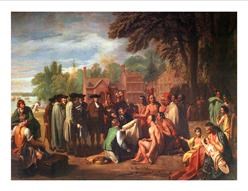
There was a time when Governors Island was called Paggnack by the Lepanae Indians who frequented the island for seasonal harvests up until 1624. Then the island was called Nutten Island by the Dutch who bought the island from the Native American tribes and used it not only for its food source but also as timber. The Dutch colonists Governors Island who came to the New York harbor under the direction of the Dutch West India Company used the trees so much that they left a saw mill on the island.The Dutch also used the island a recreational get away for the Governors of their colonies, hence the name, Governors Island. When the English took over the New York harbor, they continued to use the island for this purpose. However, Governors Island began to use the island for military purpose in the American Revolution.By the time Ft Jay was reconstructed and Castle Williams and the South Battery were completed in 1811 there was hardly a tree left on the island. But this was not the end for the once forested island. At the main entrance Ft. Jay, trees were planted in the 1850's and the City Beautiful Movement changed the design of urban planning. 
The Industrial Revolution changed not only the way goods are produced; it changed where factory workers lived. When the urban population grew in the 19th century, with it grew unsanitary and unsafe conditions in the metropolitan landscape. Cities were looked at as places to live not thrive. In the 1850's, many urban planners and designers saw this problem and proposed different land layouts to remedy city living problems, through The City Beautiful Movement; which was showcase during the 1893 Chicago World's Fair.The idea behind this design was that the city wasn't solely manufacturing works or clusters or cement and wooden boxes for those workers to simply live in. The city could also be an artistic expression, articulated through ornamental architecture, exquisite sculptures, and picturesque landscaping.The cities of the United States of America sat up and took notice, and Governors Island was no exception.Nolan park was given a country living feel while more trees were planting everywhere on the island. One of the most plentiful trees on the island (and in New York City in general) is the London Plane tree. This tree is recognizable by its pale grey-green bark, which is always smooth and exfoliating, maple-like leaves, and its fuzz seed orb. The Platanus Acerifolia or London Planetree's existence was first recorded in the 17th century. Although plentiful in the US, this tree is an international hybrid. Hailing from Europe, the London Plane tree is the amalgam of the Oriental Planetree and the Sycamore (American Planetree). It is the perfect ornamental landscaping tree because of its adaptability and it is plentiful on Governors Island.But this is not the only transnational vegetation import on the island. Robert Moses had the London Planetree planted in every park in New York City. Governor's Island also it home to other intercontinental imports such as the Japanese Pago tree and Gingko trees. 
One of the most remarkable trees on Governors Island is the Ginkgo tree (Ginkgo biloba). The Ginkgo is a living fossil, its genus is identified from fossils that date back 270 million years but what's more amazing is Today's trees are nearly identical to prehistoric trees. Only a few species of Ginkgos have ever been identified in the fossil record, and only a single species is extant. The Ginkgo is classified not just in its own family, but in a separate division of the Plant Kingdom, it is the only member of the Ginkgophyta division. Thus, it is unclear how Ginkgo is even related to other living plants is uncertain.The Female Ginkgo tree produces pinkish, naked seed that produced a stench when opened. Ginkgos are fertilized by motile sperm.So far on Governors Island, we have only found male Ginkgo trees. Governors Island is the home of 141 different species of trees, the open season commences May 26th through the end of September and it's open to the public as a park space on the weekends. Thousands of people from all over the globe get to partake in the National Monuments of the island but they also revel in and lounging on the lush greenery of Governors Island. |
Last updated: February 26, 2015
